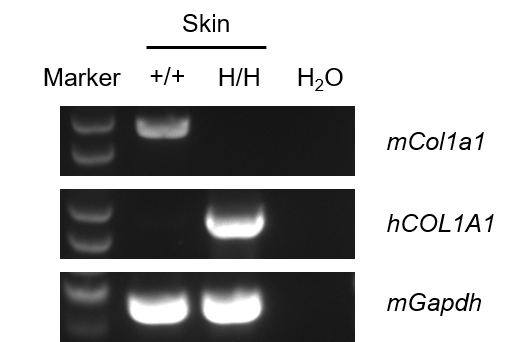Description
- Collagen is mainly synthesized by fibroblasts and is the most abundant structural protein in humans and mammals, especially in the extracellular matrix. Type I and type III collagen are the most widely used collagens. Type I collagen consists of two α1(I) chains (encoded by COL1A1 gene) and one α2(I) chain (encoded by COL1A2 gene) as heterotrimers.
- Collagen type I alpha 1 (COL1A1), a member of the collagen family, is involved in epithelial–mesenchymal transition, which is closely linked to malignant tumorigenesis.
- Gene editing strategy: The exons 1-51 of mouse Col1a1 gene is replaced by human counterparts in B-hCOL1A1 mice. The promoter, 5’UTR and 3’UTR region of the mouse gene are also retained. The human COL1A1 expression is driven by endogenous mouse Col1a1 promoter, while mouse Col1a1 gene transcription and translation will be disrupted.
- mRNA expression analysis: Human COL1A1 mRNA was detectable in homozygous B-hCOL1A1 mice but not in wild-type mice.
- Protein expression analysis: Human COL1A1 was detectable only in skin from homozygous B-hCOL1A1 mice but not in wild-type mice.
- Application: This product is used for the immune and toxicological evaluation of recombinant human collagen implants and related disease drugs.
Targeting strategy
Gene targeting strategy for B-hCOL1A1 mice. The exons 1-51 of mouse Col1a1 gene is replaced by human counterparts in B-hCOL1A1 mice. The promoter, 5’UTR and 3’UTR region of the mouse gene are also retained. The human COL1A1 expression is driven by endogenous mouse Col1a1 promoter, while mouse Col1a1 gene transcription and translation will be disrupted.
mRNA expression analysis in humanized B-hCOL1A1 mice
Strain specific analysis of COL1A1 mRNA expression in wild-type C57BL/6JNifdc mice and homozygous B-hCOL1A1 mice by RT-PCR. Skin RNA were isolated from wild-type C57BL/6JNifdc mice (+/+) and homozygous B-hCOL1A1 mice (H/H), then cDNA libraries were synthesized by reverse transcription, followed by PCR with mouse or human COL1A1 primers. Mouse Col1a1 mRNA was detectable in wild-type mice. Human COL1A1 mRNA was detectable in homozygous B-hCOL1A1 mice but not in wild-type mice.
Protein expression analysis in humanized B-hCOL1A1 mice
Western blot analysis of COL1A1 protein expression in homozygous B-hCOL1A1 mice. Various tissue lysates were collected from wild-type C57BL/6 mice (+/+) and homozygous B-hCOL1A1 mice (H/H), and then analyzed by western blot with species-specific anti-COL1A1 antibody (CST, #91144S). 50 μg total proteins were loaded for western blotting analysis. Human COL1A1 was detectable only in skin from homozygous B-hCOL1A1 mice but not in wild-type mice.
* When publishing results obtained using this animal model, please acknowledge the source as follows: The animal model [B-hCOL1A1 mice] (Cat# 113424) was purchased from Biocytogen.


